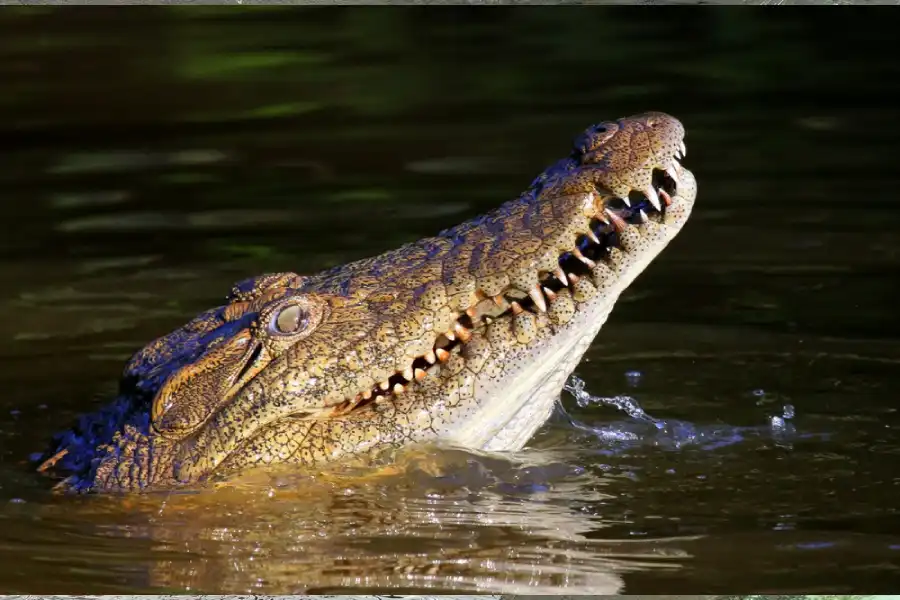How Fast Can a Crocodile Swim? Discover Their Impressive Speeds!
Crocodiles are fascinating creatures with impressive swimming abilities. They use swimming as their primary mode of transportation, and it is essential for hunting, escaping danger, and traveling long distances.
The speed at which crocodiles swim is a topic of interest for many people, especially those living in areas where these animals are present.
The swimming speeds of crocodiles vary depending on several factors such as species, size, age, and water conditions. Some species can swim at incredible speeds of up to 20 miles per hour (32 kilometers per hour), making them one of the fastest aquatic animals.
However, most crocodiles swim at a more leisurely pace of around 4-6 miles per hour (6-10 kilometers per hour).
Researchers studying the behavior and ecology of crocodiles need to understand their swimming speeds. It helps them gain insight into how these animals interact with their environment and other species.
For people living in areas where crocodiles are present, knowing their swimming speeds is crucial for safety reasons.
| Crocodile Species | Size | Habitat | Range | Conservation Status |
|---|---|---|---|---|
| Saltwater Crocodile | Up to 23 feet long and 1.5 tons | Coastal areas, estuaries, rivers | Australia, Southeast Asia, and parts of India | Least Concern |
| Nile Crocodile | Up to 20 feet long and 1 ton | Rivers, swamps, lakes | Africa | Least Concern |
| American Crocodile | Up to 15 feet long and 1 ton | Coastal areas, estuaries, rivers, and lakes | Southern United States, Mexico, Central America, and northern South America | Endangered |
| Morelet’s Crocodile | Up to 10 feet long and 100-150 pounds | Rivers, swamps, and freshwater marshes | Mexico, Central America, and parts of South America | Vulnerable |
| Siamese Crocodile | Up to 10 feet long and 300 pounds | Rivers, marshes, and lakes | Southeast Asia | Critically Endangered |
How Do Crocodiles Swim?
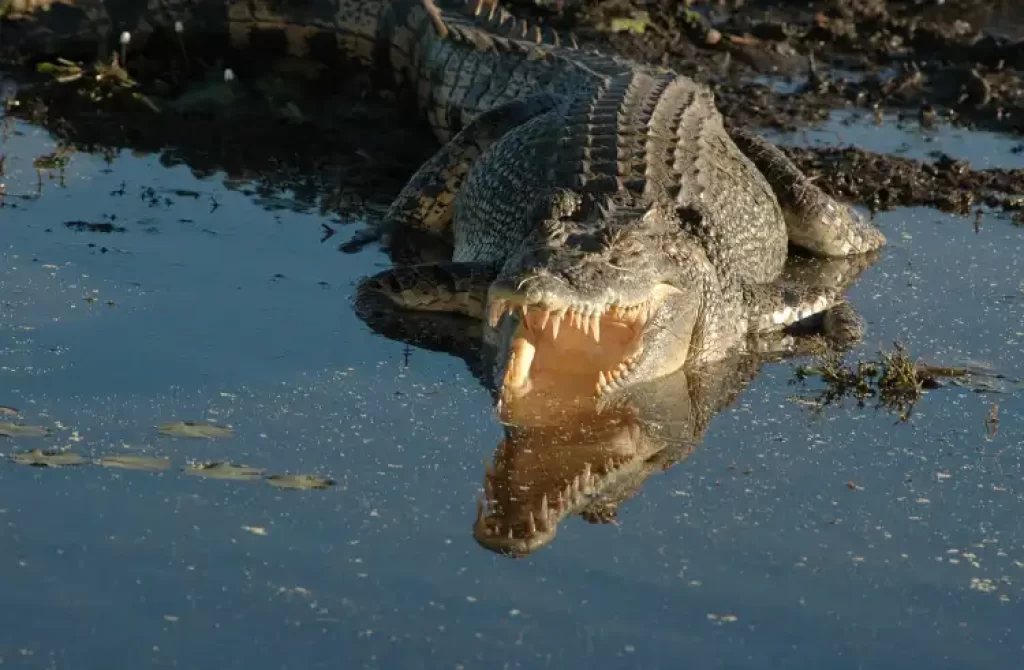
Crocodiles are fascinating creatures that have been around for millions of years. They are known for their powerful jaws and sharp teeth, but did you know that they are also excellent swimmers?
In this section, we will explore how crocodiles swim and what makes them so efficient in the water.
Crocodiles Swim by Moving Their Legs in a Paddling Motion
Crocodiles use their legs to propel themselves forward. They move their legs in a paddling motion, similar to how humans swim. However, unlike humans who use their arms to help them swim, crocodiles rely solely on their legs.
The Nile crocodile is one of the most common species of crocodile found in Africa. It has four short and stocky legs that are perfectly adapted for swimming. The muscles in its legs are incredibly strong and allow it to move through the water with ease.
Their Powerful Tails Also Play a Crucial Role in Their Movement
In addition to using their legs to swim, crocodiles also use their tails. Their tails are long and muscular and play a crucial role in steering and changing direction while swimming.
When a crocodile wants to change direction while swimming, it will use its tail as a rudder. By moving its tail from side to side, it can quickly change course without losing momentum.
Crocodiles Are Able to Float on the Water’s Surface Due to Their Buoyancy
Another reason why crocodiles are such good swimmers is because of their buoyancy. Crocodiles have air sacs in their lungs that help them float on the water’s surface. This allows them to conserve energy while they swim.
Crocodiles have an interesting adaptation that helps them maintain buoyancy even when they dive underwater.
When they dive, they close off their nostrils and ears so that no water can enter. This helps prevent them from sinking too deep and allows them to stay underwater for longer periods of time.
When Swimming, Crocodiles Can Hold Their Breath for Up to an Hour
Speaking of staying underwater, crocodiles are incredibly skilled at holding their breath. When they dive, they can hold their breath for up to an hour. This is because they have a special adaptation that allows them to conserve oxygen while they are submerged.
Crocodiles have a four-chambered heart that helps them regulate their blood flow and conserve oxygen. They also have the ability to slow down their metabolism when they are not moving, which helps them use less energy and oxygen.
In Addition to Swimming, Crocodiles Are Also Capable of Rolling in the Water
While swimming is important for crocodiles, it’s not the only way they move through the water. They are also capable of rolling in the water, which helps them disorient and overpower their prey.
When a crocodile wants to catch its prey, it will often roll over and drag its prey underwater. This makes it difficult for the prey to escape and increases the chances of a successful hunt.
Summary of Crocodile Swimming Speeds
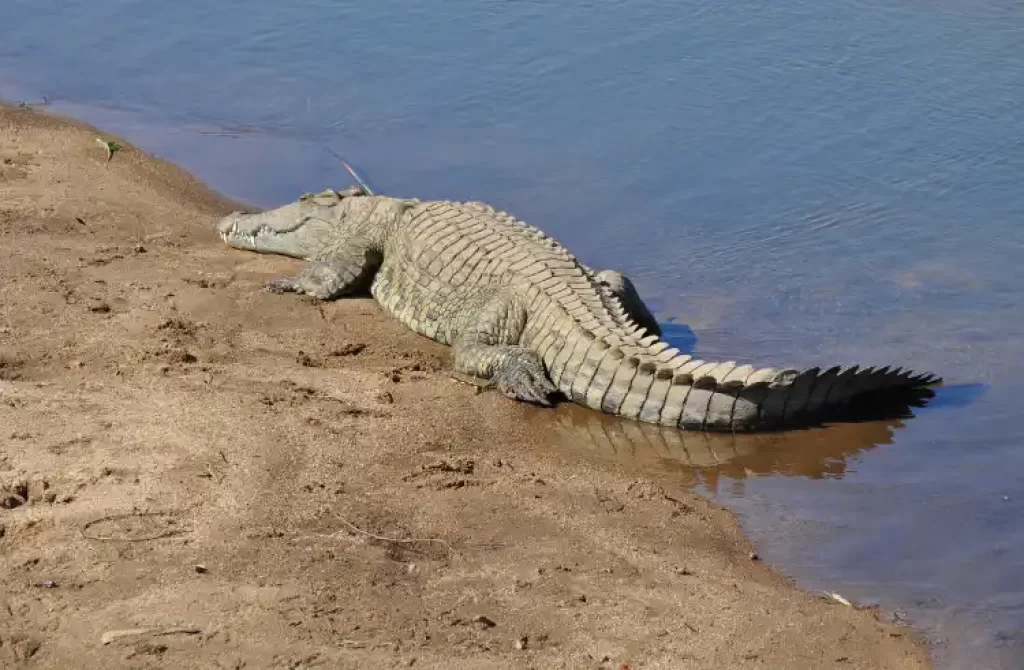
Crocodiles are known for their powerful swimming abilities. They are one of the most efficient hunters in the water, thanks to their impressive swimming speeds and agility. In this section, we will discuss the summary of crocodile swimming speeds.
Average Swimming Speed
The average swimming speed of a crocodile is around 20-25 km/h (12-15 mph). This speed is fast enough to catch prey that is trying to escape from them. However, it is not as fast as some other aquatic animals like dolphins or killer whales.
Saltwater Crocodile
Some species of crocodiles, such as the saltwater crocodile, can swim at speeds of up to 30 km/h (18.6 mph). The saltwater crocodile is the largest living reptile and also one of the fastest swimmers among all crocodile species. It can grow up to 23 feet long and weigh more than a ton.
Efficient Hunters
Crocodiles are able to maintain their swimming speed for long periods of time, making them efficient hunters in the water. They can swim at a steady pace for hours without getting tired or slowing down. This makes it easier for them to catch prey that may be trying to escape from them.
Agile Swimmers
Despite their size and weight, crocodiles are surprisingly agile swimmers and can make sudden turns and changes in direction while swimming.
They use their powerful tails and webbed feet to propel themselves through the water with ease. Their streamlined bodies allow them to move quickly through the water without creating much resistance.
There have been many examples where crocodiles have shown their impressive swimming abilities in various situations. For instance, during floods or heavy rains, crocodiles have been known to swim long distances across flooded areas in search of food or new habitats.
There have been many studies conducted on crocodile swimming speeds that show how efficient they are in the water. These studies have been able to measure their swimming speeds using various methods, including tracking devices and underwater cameras.
According to a study conducted by the University of Florida, crocodiles can swim at an average speed of 20-25 km/h (12-15 mph). However, this speed can vary depending on factors such as the species of crocodile, age, size, and environmental conditions.
Can Humans Outswim Crocodiles?
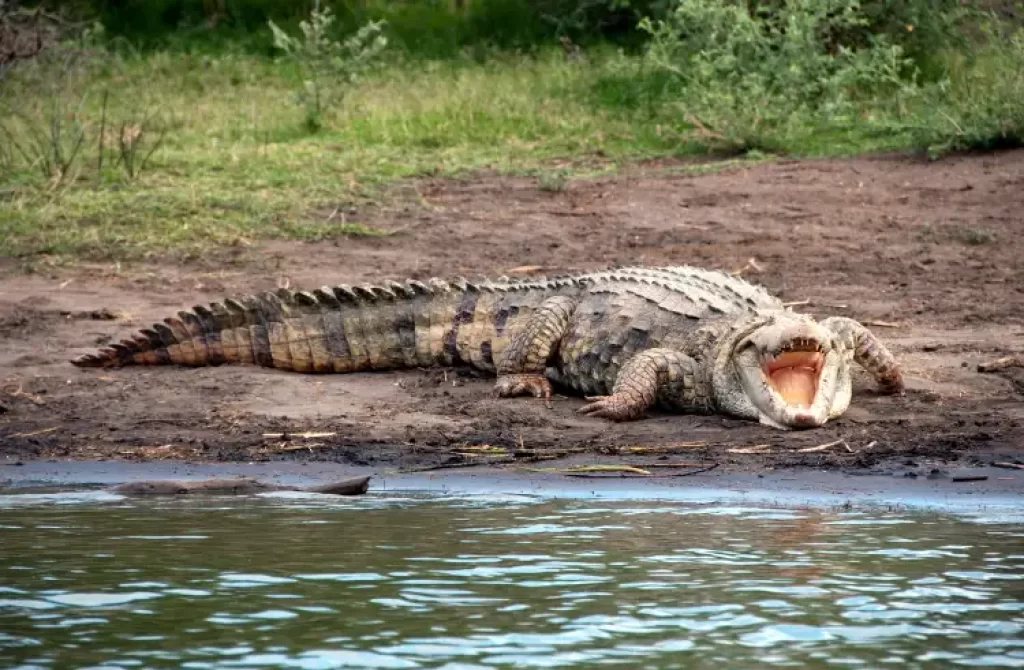
Crocodiles are known for their powerful tails and strong jaws, making them one of the deadliest predators in the animal kingdom. They can swim at incredible speeds, which begs the question: Can humans outswim crocodiles? Unfortunately, the answer is no.
Humans cannot outswim crocodiles in water due to several factors. Firstly, crocodiles have a streamlined body shape that allows them to move through water with minimal resistance.
Secondly, their muscular tails provide them with immense propulsion power that enables them to reach high speeds quickly.
Finally, their strong jaws allow them to catch prey effortlessly and hold onto it until it drowns or suffocates.
Crocodiles are also known to attack humans who enter their territory or disturb them in any way. These attacks can be fatal as crocodiles are incredibly strong and can easily overpower a human being. As a result, it is essential for people to avoid swimming or wading in areas where crocodiles are known to inhabit.
In case of an attack by a crocodile, humans should try to stay calm and use any available objects or air pockets to defend themselves until help arrives.
It is crucial not to panic as this will only agitate the crocodile further and make matters worse. Instead, try to keep as still as possible while using any available resources such as sticks or rocks to fend off the predator.
There have been several instances where people have managed to survive a crocodile attack by using these techniques successfully.
For example, in 2018, a British woman named Melissa Laurie was attacked by a crocodile while swimming in Mexico’s Manialtepec Lagoon with her twin sister Georgia Laurie. Melissa managed to survive by punching the reptile repeatedly in its face until it let go of her.
Another example is that of Australian teenager Lee de Paauw who survived an attack by punching a saltwater crocodile repeatedly after it bit him on the arm. The attack occurred when Lee jumped into the Johnstone River in Queensland, Australia, to impress a girl he had just met.
In late 2022, there was another incident in Brazil where a man was attacked by a caiman while swimming in a local lake. Fortunately, the man was able to escape safely after the frightening experience, and it seems that he did not suffer any serious injuries.
Here’s the original video:
These examples show that it is possible to survive a crocodile attack if one remains calm and uses any available resources to defend oneself. However, prevention is always better than cure, and people should avoid swimming or wading in areas where crocodiles are known to inhabit.
Are Crocodiles Faster in Water Than on Land?
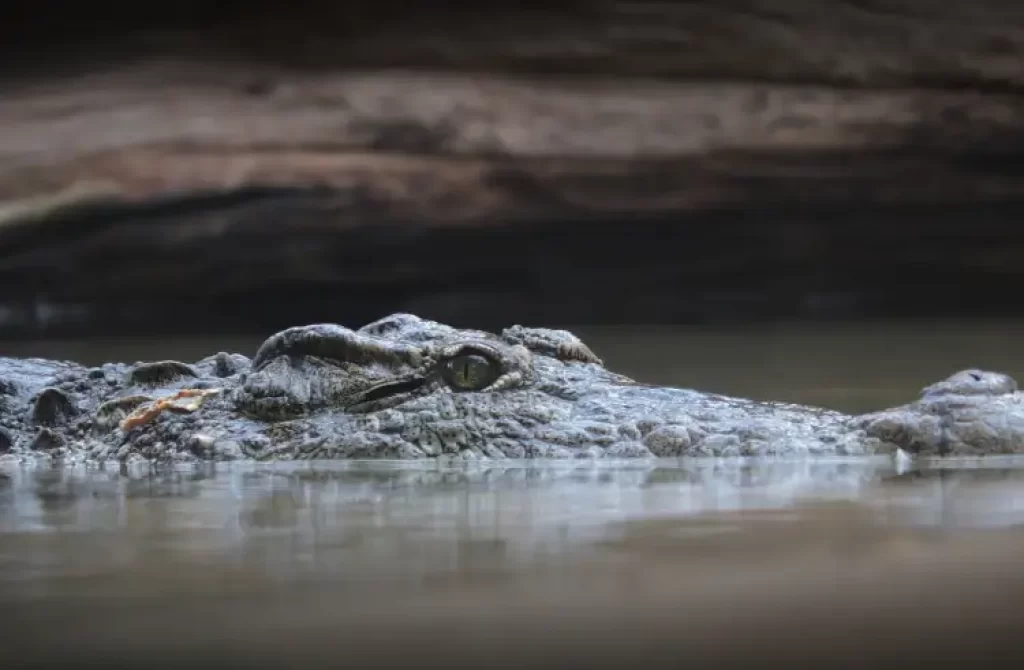
Crocodiles are fascinating creatures that have been around for millions of years. They are known for their ability to swim and hunt in water, but how fast can they really move? Are crocodiles faster in water than on land? The answer is yes, and there are several reasons why.
Streamlined Body Shape
Crocodiles have a streamlined body shape that allows them to move quickly through the water. Their long, slender bodies are designed to reduce drag and increase speed. This body shape also helps them to conserve energy while swimming, as they do not need to use as much force to propel themselves forward.
Powerful Tail
In addition to their streamlined body shape, crocodiles also have a powerful tail that propels them forward in the water. Their tails are muscular and flexible, allowing them to generate a lot of force with each stroke. This enables them to reach high speeds when swimming.
Short Legs and Heavy Body
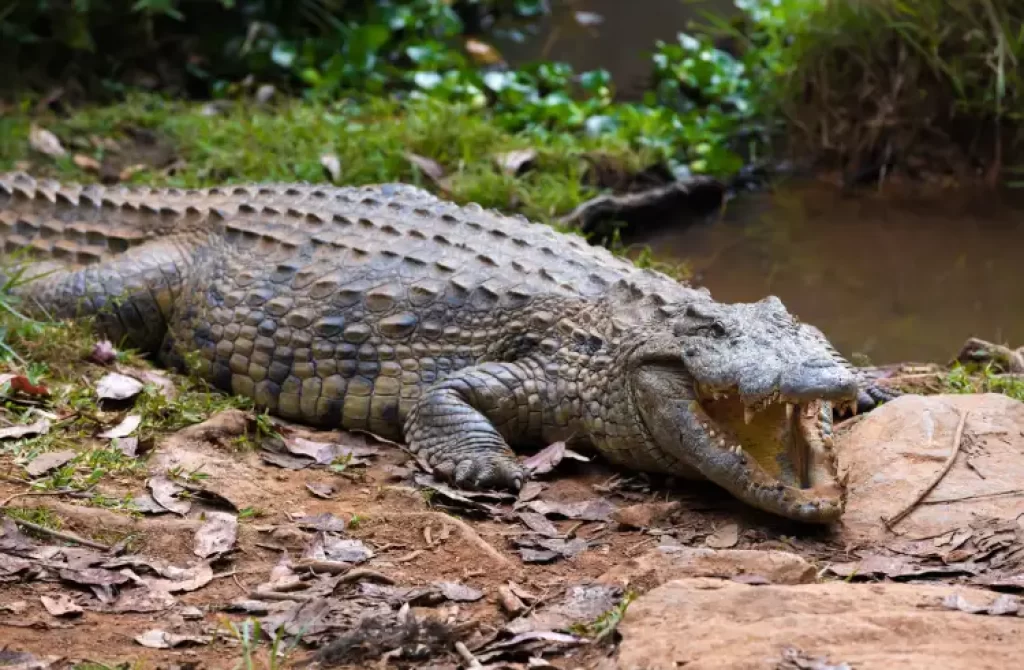
On land, however, crocodiles face some challenges which limits their speed on land.
Speed on Land vs Underwater
So just how fast can crocodiles move on land versus underwater? On average, crocodiles can run at speeds of around 10 miles per hour on land. However, this is only sustainable for short distances before they tire out.
Underwater, crocodiles can swim at much higher speeds. They are capable of reaching speeds of up to 20 miles per hour when swimming underwater.
This is due in part to their streamlined body shape and powerful tail that allow them to glide through the water with ease.
Fastest Swimming Crocodile Species
Of all the different types of crocodiles, saltwater crocodiles are known for being the fastest swimmers. These massive reptiles can reach speeds of up to 25 miles per hour in short bursts. This makes them one of the fastest swimming reptiles in the world.
Moving Quickly on Land
Despite their impressive swimming abilities, crocodiles are still able to move quickly on land when necessary. They may not be as fast as other animals, but they are certainly capable of short sprints and ambushes when hunting prey.
How Fast Can Crocodiles Run?
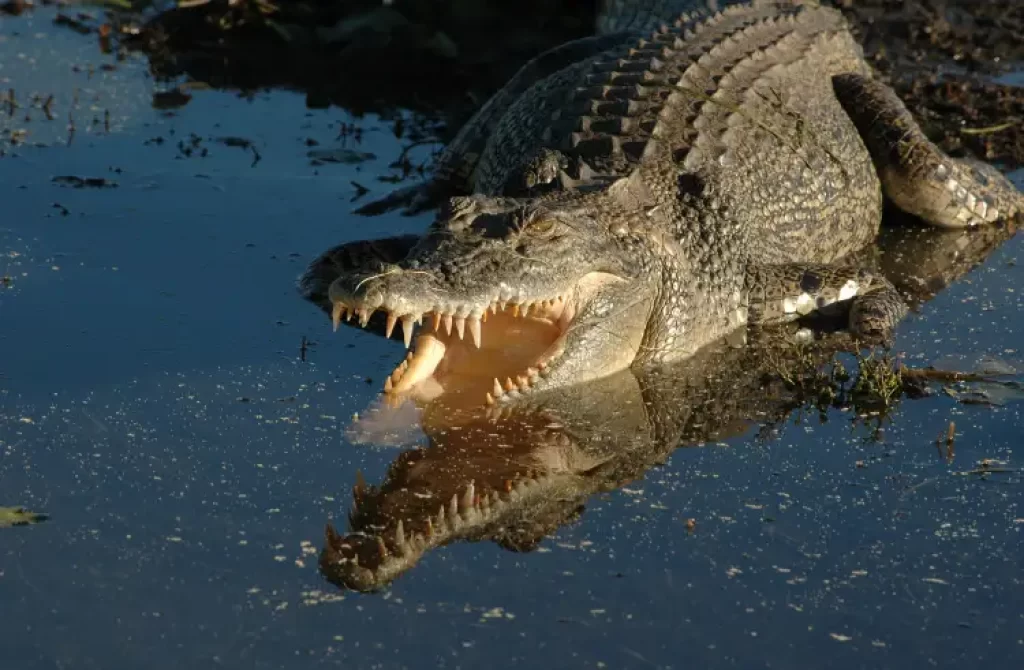
Crocodiles are not typically known for their running speed, but they are capable of reaching impressive speeds over short distances.
The top speeds of crocodiles vary depending on the species, with some able to reach speeds of up to 20 miles per hour in short bursts. However, it’s important to note that while crocodiles can run on land, they are primarily aquatic animals and are much faster and more agile in the water.
A crocodile’s length and body shape play a significant role in determining their speed. Crocodiles with longer legs and streamlined bodies are better equipped for fast running speeds. In general, larger species tend to be slower runners than smaller species due to their size and weight.
While crocodiles may not be built for endurance running, they can maintain an average speed of around 6-8 miles per hour over longer distances.
This is still quite impressive considering their size and weight. In fact, some experts believe that the ability to run at moderate speeds over long distances may have helped early crocodile ancestors survive during times when water sources were scarce.
It’s also worth noting that a crocodile’s speed on land can vary depending on factors such as terrain and temperature.
For example, a crocodile may struggle to run quickly through thick vegetation or over rough terrain. Additionally, cooler temperatures may slow down a crocodile’s metabolism and make them less active overall.
Despite these limitations, there have been many documented instances of crocodiles outrunning humans or other animals over short distances.
For example, researchers have observed Nile crocodiles chasing down impalas in Africa at speeds of up to 10 miles per hour. Similarly, saltwater crocodiles have been known to chase down prey on land at impressive speeds.
Why Can Crocodiles Run So Fast?
Crocodiles are known for their incredible speed and agility, which they use to catch prey in both water and on land. But why can crocodiles run so fast? In this section, we’ll explore the reasons behind their impressive speed and how it helps them survive in the wild.
Efficient Hunters
Crocodiles are apex predators that need to be able to catch a variety of prey in order to survive. Their diet includes fish, birds, reptiles, and mammals such as antelope and buffalo. To catch these animals, crocodiles need to be fast and agile.
Powerful Leg Muscles
One reason why crocodiles can run so fast is due to their powerful leg muscles. These muscles allow them to generate a lot of force when pushing off the ground, which propels them forward at high speeds. In fact, some species of crocodile can reach speeds of up to 20 miles per hour on land!
Streamlined Body Shape
Another factor that contributes to a crocodile’s speed is its streamlined body shape. Crocodiles have long, slender bodies with strong tails that help propel them forward through the water or across land. This shape reduces drag and allows them to move more efficiently through their environment.
Force Generated by Tail
The force generated by a crocodile’s tail is also an important factor in its ability to run so fast. When swimming or running on land, crocodiles use their tails like rudders to steer themselves in different directions. The tail also provides additional propulsion when moving through water or across land.
Short Bursts of Speed
While crocodiles are capable of reaching high speeds over short distances, they cannot maintain this pace for very long. Instead, they rely on short bursts of speed to catch their prey before it has a chance to escape. Once they have caught their prey, they will often drag it into the water where they can consume it safely.
Survival in the Wild
The ability to run so fast is a crucial survival skill for crocodiles. It allows them to catch prey more efficiently and avoid becoming prey themselves. In addition, their speed helps them escape from danger and defend their territory against competitors.
Examples of Crocodile Speed
There are many examples of crocodiles using their impressive speed to catch prey in the wild. For instance, Nile crocodiles have been observed catching gazelles as they come down to drink at the river’s edge. Saltwater crocodiles have been known to attack water buffalo on land, using their powerful jaws and legs to bring down these massive animals.
Social Proofs of Crocodile Speed
In addition to these examples, there are also many social proofs that demonstrate just how fast crocodiles can run. For instance, researchers have used high-speed cameras to capture footage of crocodiles running and swimming at incredible speeds. These videos provide a fascinating glimpse into the world of these powerful predators.
Statistics on Crocodile Speed
Finally, there are some statistics that help illustrate just how impressive a crocodile’s speed can be. As mentioned earlier, some species can reach speeds of up to 20 miles per hour on land. In water, they can swim even faster – up to 30 miles per hour! These speeds make them one of the fastest reptiles in the world.
Are Crocodiles More Dangerous Than Alligators?
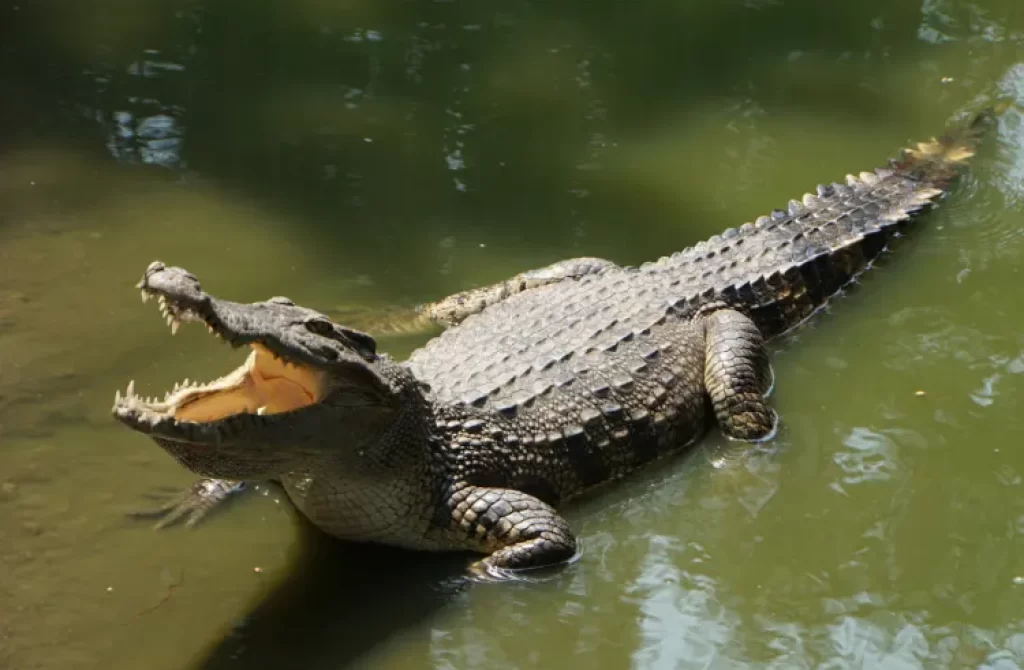
Alligators and crocodiles are often confused with each other, but they are two different species of reptiles. Both alligators and crocodiles are apex predators that have been around for millions of years.
However, there is a common question that arises when it comes to these two creatures: which one is more dangerous?
Alligators are generally less aggressive than crocodiles, and attacks on humans are rare. In fact, according to the Florida Fish and Wildlife Conservation Commission, the likelihood of being seriously hurt by an alligator in Florida is roughly one in 3.2 million. This statistic shows that although alligators may be powerful creatures, they pose little threat to humans.
However, when an alligator does attack, it can be just as deadly as a crocodile due to its powerful bite and death roll technique.
The death roll is a technique used by both alligators and crocodiles to subdue their prey by grabbing onto it with their jaws and spinning rapidly until the prey is disoriented or dead. This technique can also be used against humans who get too close to these animals.
It’s important to remember that both alligators and crocodiles should be treated with caution and respect in their natural habitats. These animals are wild creatures that should not be approached or provoked under any circumstances.
Alligator Attacks
Although attacks on humans by alligators are rare, they do happen from time to time. In 2018, a woman was killed while walking her dogs near a lake in South Carolina after being attacked by an alligator.
Similarly, in 2016, a toddler was dragged into the water at Disney World Resort in Florida by an alligator while playing near the shore.
These incidents show that even though attacks on humans by alligators are rare, they can still happen unexpectedly. Therefore, it’s important for people living or visiting areas where these animals live to take precautions such as staying away from the water’s edge, keeping pets on a leash, and avoiding swimming in areas where alligators are known to live.
Crocodile Attacks
Crocodiles are generally more aggressive than alligators and have been known to attack humans more frequently. In fact, according to National Geographic, crocodiles kill hundreds of people each year. This statistic shows that crocodiles are not to be taken lightly and should be avoided at all costs.
One example of a deadly crocodile attack occurred in 2018 when a man was killed while fishing in Australia’s Northern Territory. The man was attacked by a saltwater crocodile, which is one of the largest and most dangerous species of crocodile in the world.
Another example occurred in 2019 when a woman was killed while snorkeling off the coast of Mexico by a saltwater crocodile. These incidents show that even though attacks on humans by crocodiles may be less common than attacks by alligators, they can still happen unexpectedly and with deadly consequences.
Other Interesting Facts About Crocodiles
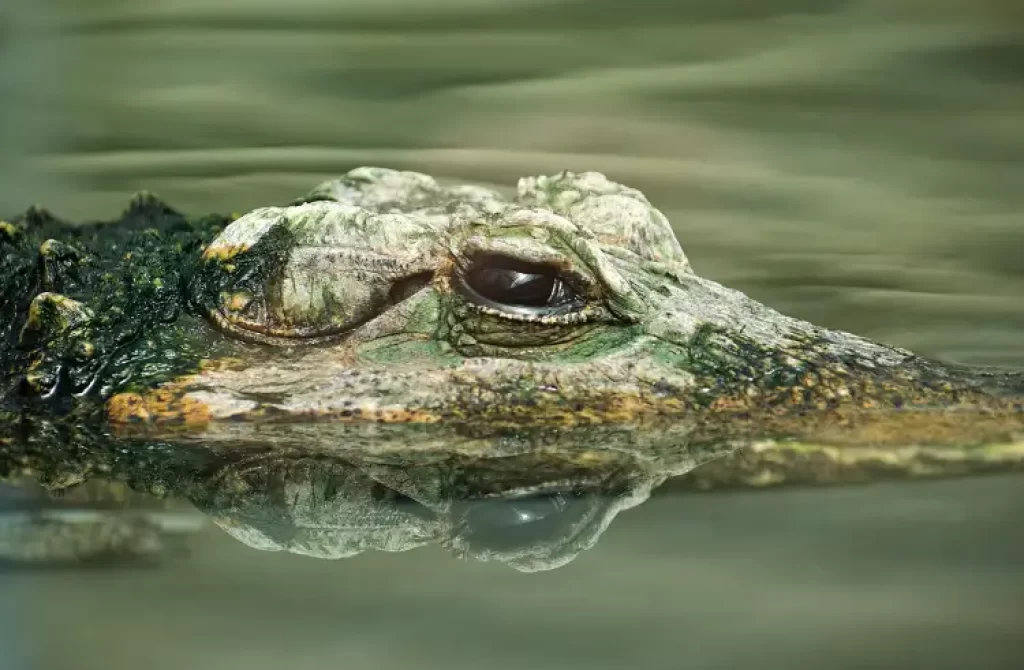
Crocodiles are fascinating creatures that have been around for millions of years. They are one of the oldest living reptiles on Earth, with fossils dating back more than 200 million years. These ancient creatures have many interesting facts and characteristics that make them unique.
The saltwater crocodile is the largest living reptile in the world, with males growing up to 23 feet long and weighing over a ton. These massive animals can be found throughout Southeast Asia, Northern Australia, and the surrounding islands. Saltwater crocodiles are known for their aggressive behavior and powerful jaws, which can exert a force of up to 3,000 pounds per square inch.
Nile crocodiles are responsible for more human fatalities in Africa than any other large animal, with an estimated 200 deaths per year. These deadly predators can be found throughout sub-Saharan Africa and are known for their ability to take down large prey such as wildebeest and zebras. Nile crocodiles have also been known to attack humans who venture too close to their territory.
Most crocodiles feed primarily on fish but will also eat birds, mammals, and other aquatic animals. Crocodiles have incredibly powerful digestive systems that allow them to break down tough materials like bones and shells. Researchers have even found stones in the bellies of some crocodiles that they use as gastroliths to help grind up food.
Crocodiles have incredibly strong jaws that allow them to bite down with tremendous force. In fact, their bite is one of the strongest bite forces of any animal species on Earth. Crocodile attacks on humans are rare but when they do occur they can be deadly due to the sheer power behind their jaws.
Despite their fearsome reputation as predators, crocodiles play an important role in maintaining balance within aquatic ecosystems. As top predators, they help regulate populations of other animals such as fish and turtles.
In addition to their physical characteristics, crocodiles have many interesting behaviors and adaptations that make them unique.
For example, they are able to regulate their body temperature by basking in the sun or retreating to the water when they get too hot. They also have a special valve in their heart that allows them to hold their breath for extended periods of time while underwater.
Crocodiles are fascinating creatures that have captured the imagination of people for centuries. From their ancient origins to their powerful jaws and deadly attacks, these creatures continue to intrigue researchers and nature enthusiasts alike.
How Fast Can a Crocodile Swim and Its Implications
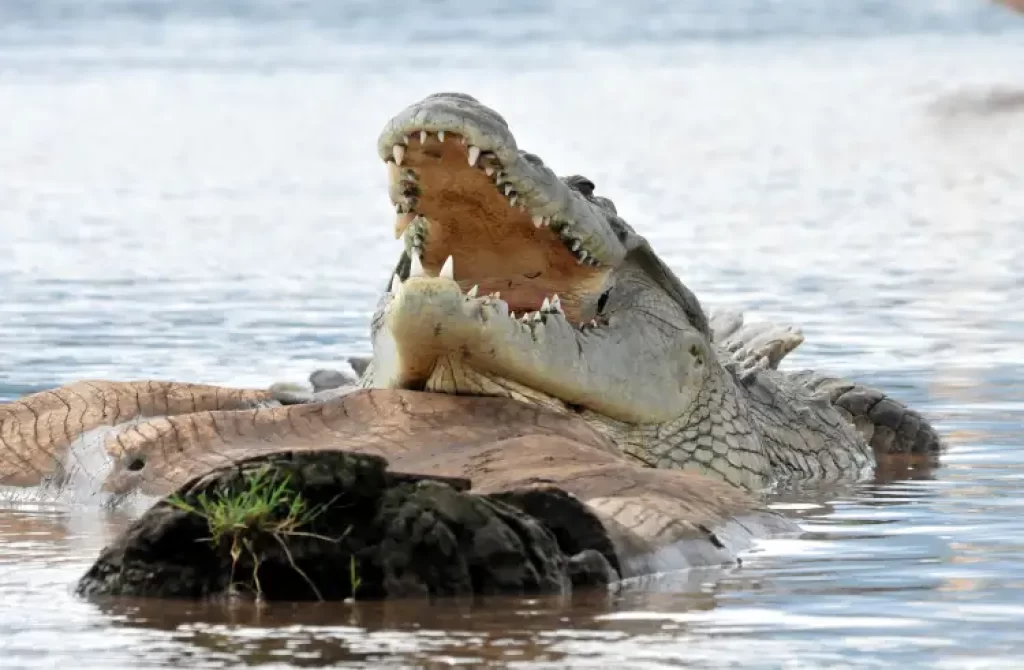
In conclusion, crocodiles are some of the most fascinating creatures on the planet. They have been around for millions of years and have evolved to become highly efficient predators both in water and on land. crocodiles are incredibly fast and can reach speeds of up to 20 miles per hour.
Understanding how fast crocodiles can swim is not only important from a scientific perspective but also has practical implications. For example, if you live near an area where crocodiles are known to inhabit, it’s essential to be aware of their swimming abilities and avoid getting too close to them when they’re in the water.
Furthermore, knowing how fast crocodiles can swim can also help us better understand their behavior in the wild. For instance, researchers have discovered that crocodiles use different swimming techniques depending on their speed.
At slower speeds, they use a more energy-efficient method known as undulatory swimming, while at higher speeds, they switch to a more powerful tail-driven technique.
Overall, studying the swimming abilities of crocodiles is just one small part of our ongoing efforts to learn more about these incredible animals.
By continuing to research and study them, we can gain valuable insights into their behavior, biology, and ecology – insights that could ultimately help us protect them from extinction.
If you found this article interesting, we invite you to explore other articles related to crocodiles on our website. You can learn more about their behavior, habitat, and conservation efforts, as well as other fascinating facts about these ancient reptiles.
For example, did you know that crocodiles are excellent parents and will fiercely protect their nests and young? Or that some species of crocodiles can grow up to 23 feet long and weigh over a ton?
We hope that by sharing our knowledge and love for these creatures, we can inspire others to appreciate and respect them as well. Thank you for reading!


